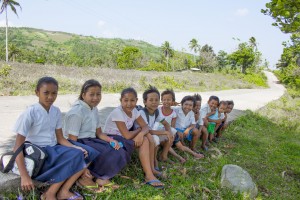
“Masemento gayud yan, gadan na ako (By the time the road is cemented, I’ll be dead).”
This was the usual lament of Austerio Asero, according to his daughter, Jennifer, 32. With tears in her eyes, she recalled how she bantered with her father, saying, “Patitinampo ko yan. Hilingon mo, Tay (I will construct the road. You’ll see, Father).”
Unfortunately, Austerio died in 2010, without ever seeing his dream of having a cemented road fulfilled.
The village of Caranday
The agricultural town of Baao, an upland area, is a poor municipality in Camarines Sur, with a poverty incidence of 37.35. Some 3,380 of its 5,729 households identified as poor in 2011 by Listahanan, the information management system of Department of Social Welfare and Development (DSWD).
Barangay Caranday is one of its 30 villages. Of its 179 households, 165 live below the poverty threshold because most of its residents do not have a permanent source of income and could barely send their children to college.
Sixty-nine households in the village belong to the Agta Tabangnon and Agta Cimarron tribes. Their ancestors have inhabited these remote mountains of Baao prior to the lowlanders settling there.
Jennifer takes her Indigenous Peoples (IP) lineage from her mother, Cynthia, who was an Agta Tagbangon. Her husband, Danilo, is also an Agta Tagbangnon.
Like the other members of their tribe, she and Danilo are farmers and livestock raisers. Unfortunately, their tribes’ crops often get spoiled during transport because of their uneven road, which is just a little more than a dirt path of packed clay. As such, they could not fetch good prices for their products – coconuts, corns, squashes, string beans and bananas – with buyers purchasing these at much cheaper rates.
Between the two of them, Jennifer and Danilo earn P2,000 per month from tandan, or working on a landlord’s farm, barely enough to support their four children.
The poor road condition also made it difficult for the sick people to get medical aid, and for students to get to and from school at the town proper.
Like her father, Jennifer dreamt of having a decent road that connects Sitio Banay to the town proper of Caranday, knowing firsthand just how difficult it was to traverse a dangerous path. Not only do travelers have to contend with large rocks and dust or mud, depending on the weather, they also had to deal with other elements as well.
“Dipisil talaga. Malumpat ka sa kagagapuan, eh, kung may alas pa? (It’s really hard. You cross across rocks. What if there are snakes?),” she asked.
Hope of a dead man’s daughter
Hope flared when she heard about the possibility of finally getting a decent road through the Kapit-Bisig Laban sa Kahirapan-Comprehensive and Integrated Delivery of Social Services (Kalahi-CIDSS), a DSWD program that seeks to help alleviate poverty using the community-driven development (CDD) strategy.
She always made sure to attend meetings, even though attendance meant going on a 30 minute-walk from their house to the venue. Others mocked Jennifer’s diligence, telling her she would get nothing but another empty promise. Her determination, however, quelled their protests.
“Magdisidir kita. Sige sige sana. Ipakita ta na kita desidido tanganing magkatinampo kita (We should stand strong. Let us continue what we are doing. Let us show them that we are serious about getting the roads concreted),” she encouraged her detractors.
“Nagpa-apod kami ning rabos ta kami man lang makikinabang kaini (We called for the community’s collaborative effort because we are the ones who will benefit from this),” Jennifer also said.
Eventually, the Barangay Caranday villagers, the lowlanders and the Agtas alike, worked together to get their 1.19-km road paved in 2014 through Kalahi-CIDSS.
Being a CDD program, Kalahi-CIDSS is implemented by mobilizing citizens so they themselves can choose, implement, manage, and maintain their chosen sub-project.
Jennifer became one of its volunteers, chosen by the majority of the residents of Barangay Caranday as the Bids and Awards and Committee (BAC) Chairperson, who is responsible for determining which interested suppliers of goods, materials, equipment and equipment rental will be eligible for supporting the construction.
“Sa sarong project, hindi pwede bumili ng basang (In this project, we should not vacillate when procuring),” she explained.
From one generation to the next
Being a high school graduate did not deter her from performing her goals as the Committee Chairperson. She even did what she could to help the other community volunteers perform their functions.
“Gusto kong makatabang pa ako sa iba (I would like to help others),” she said.
She asked her husband to help out in the road construction. Jennifer herself also served as one of the laborers, not knowing that she was five months pregnant at the time.
Together with Judith Cron, a relative, Jennifer came to the belief that the efforts they put into their road sub-project will leave a legacy for the benefit of the coming generations. Their children will honor them because the convenience they will enjoy is the result of their parents’ sacrifices.
With the completion of their road, which amounted to P2.61 million, they saw that that was exactly what happened.
“Proud sila na ining tinampo natapos dahil sa kontribusyo ng magulang nila (They are proud that the road was completed because of their parents’ contribution),” Jennifer said.
The road benefits 100 households in Brgy. Caranday. It also provides access to its neighboring villages, namely, Cristo Rey, Iyagan, and Tapol.
“Kaming mga Agta, mas nabenepisyaran igdi. Pasil na sana ta bakong malaboy. Hindi na mapapagod at mahihirapan yung matatanda (Agtas like us benefit from this. Crossing it is easy and the road is not muddy. Elders will not get tired and experience difficulty in traveling),” Jennifer said.
With the road completed, Jennifer now imagines their community as a developed one, complete with electricity, a water system, an evacuation center for the Agtas, and a supermarket in their village. Now, she dreams of the children of Barangay Caranday enjoying these in their lifetime.
With the road constructed four years after his death, Jennifer’s father was not able to live to see it concreted at last. Even so, his daughter believes that his dream has been realized.
She said,“Basta naiiling ko ining tinampo, si tatay ang naalala ko (I remember my father whenever I look at the road).”
While Austerio was not able to see the concreted pavement, it was his wish that became Jennifer’s motivation to see the sub-project through, and this in turn will allow her child – and the other members of the following generations – to benefit from her and the other villagers’ efforts.###


